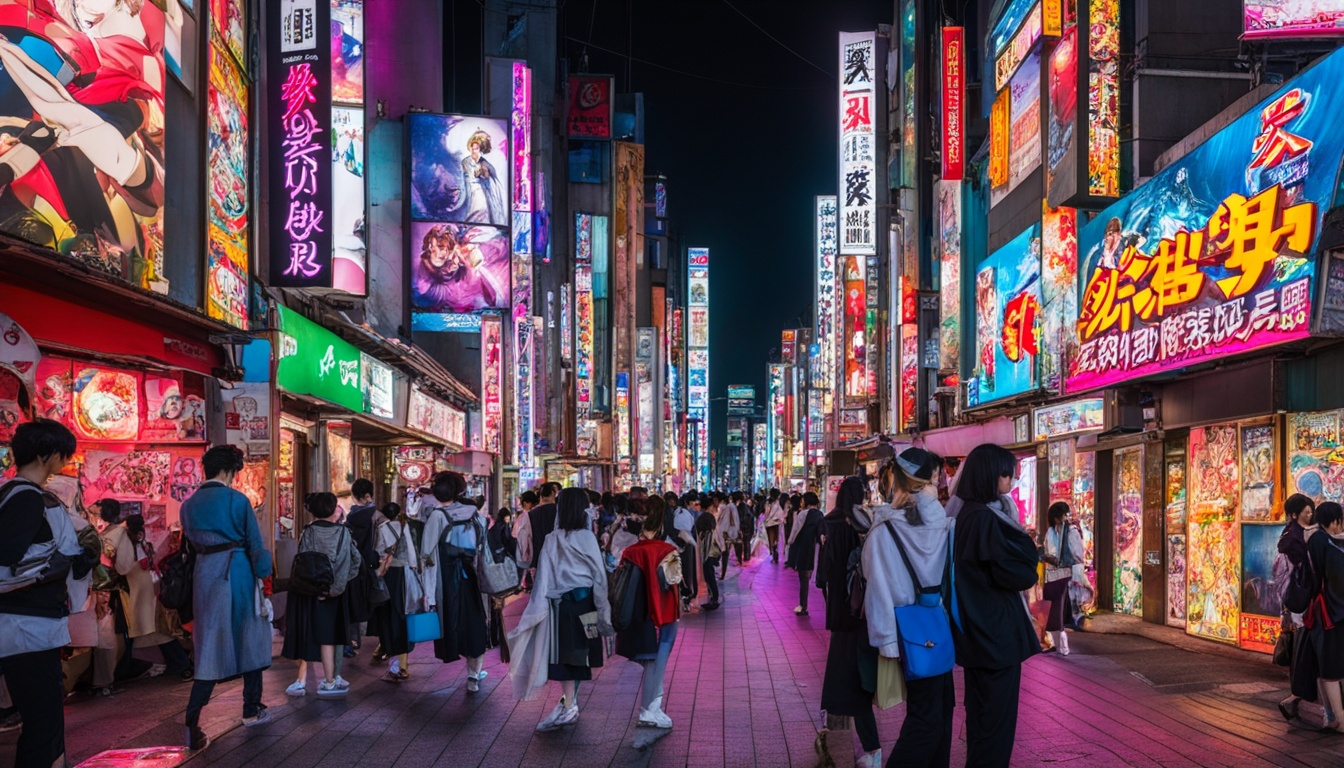Did you know Japanese pop culture is loved worldwide? It includes anime, manga, J-pop, and video games. These things have become a big part of global entertainment. They inspire trends and capture hearts, from Harajuku’s lively streets to high-tech anime and J-pop tunes.
Key Takeaways:
- Japanese pop culture encompasses various genres, including anime, manga, J-pop, and video games.
- Translating Japanese pop culture presents unique challenges due to cultural idioms, slang, and references.
- High-quality translations are essential in preserving the nuances of Japanese pop culture.
- Japanese pop culture is popular worldwide because of its creativity, innovation, and emotional depth.
- There are numerous resources available, such as websites, books, and podcasts, for learning and gaining insights into Japanese pop culture.
The Appeal of Anime and Manga
Anime and manga are huge in Japan and around the world. Anime means Japanese animation, full of visual stories and action. Then, there’s manga – Japanese comic books with amazing art and stories.
These two types of media cover all kinds of themes and stories. You can find anything from sci-fi and fantasy to simple and touching tales. Their popularity has flown beyond Japan, drawing fans of all kinds.
The art in anime and manga is a big part of why people love them. Anime uses bright colors and lifelike movements. Manga is detailed and lets readers pace themselves through stories.
They’re also great at showing complex feelings and ideas. They talk about everything from love and friendship to big world problems and even supernatural stuff. This makes them really engaging for people of any age.
Everyone can join in, because so many manga have been translated into English recently. Also, you can watch lots of anime on the internet. This means fans can always find something new to read or watch.
Choosing what to read or watch often comes from friends or ads. There’s something for everyone, like shōnen for boys or shōjo for girls. Such variety lets every reader find something they love.
Even schools are seeing the value of manga. Stories with relatable characters get students’ attention. They encourage creativity and thinking in fun new ways.
Recommended Manga Titles:
- Black Jack
- Nausicaä of the Valley of the Wind
- Inu-yasha: A Feudal Fairy Tale
- One Piece
Looking closely at anime and manga can be eye-opening. The way artists use different techniques adds a lot to the story. It’s not just beautiful; it’s smart, too.
Studying the content can teach us about a culture or society. It’s like looking through a window into Japan’s heart. And understanding the time when these stories were born makes them even more interesting.
People can also learn a lot from manga. Students can use it to explore all kinds of fields, from art to science. It’s a fun way to study and see the connections between different subjects.
Manga and anime are more than just fun; they’ve made a big impact. Visionaries like Osamu Tezuka started something special. Now, creators like Naoko Takeuchi and Hiromu Arakawa keep making amazing stories. They’ve all helped shape how we see the world of manga and anime.
They open doors to new worlds, touch our hearts, and make us think. Anime and manga have become symbols of Japan that the whole world loves. And they keep inspiring new stories and new fans everywhere.
| Stats | Description |
|---|---|
| Manga Volumes | Thousands of manga volumes have been translated into English over the past decade, making them accessible to high school and college students. |
| Education | Shōnen and shōjo manga are especially appropriate for classroom use, offering engaging narratives and relatable characters. |
| Recommended Titles | Popular manga titles include “Black Jack,” “Nausicaä of the Valley of the Wind,” “Inu-yasha: A Feudal Fairy Tale,” and “One Piece.” |
| Technical Analysis | Analyzing artistic techniques, such as exaggeration, cross-hatching, and panel composition, adds depth to the appreciation of manga. |
| Content Analysis | Identifying recurring themes, topics, and discussing issues raised in manga enhances the understanding of its cultural significance. |
| Contextual Analysis | Exploring the local and global contexts during the time of creation provides insights into the message conveyed by manga. |
| Student Research | Manga can serve as a stimulus for student research projects across various subjects, encouraging interdisciplinary exploration. |
| Industry Impact | Anime and manga have expanded their reach, impacting global popular culture and inspiring new generations of fans. |
The Influence of J-pop Music
J-pop, or Japanese pop music, is a big part of pop culture in Japan. It’s not just big in Japan, but worldwide. Its upbeat tunes, catchy rhythms, and top performers grab the world’s attention.
J-pop blends different music types to suit many tastes. It draws from Japan’s traditional music and 1960s pop and rock. In the 1960s–1970s, bands like Happy End mixed Western rock with Japanese sounds, making something unique.
In the 1990s, J-pop became a hit in Japan, a big achievement for the genre. It has since evolved, giving us varieties like technopop, city pop, and Shibuya-kei. These styles show how J-pop has changed with the times.
J-pop’s success worldwide is thanks to its unforgettable tunes. Whether it’s a heartfelt song or a dance hit, J-pop knows how to catch your ear. Its mix of upbeat music and meaningful lyrics touches fans around the globe.
Many J-pop stars are known everywhere, bridging languages with their music. Their lively acts and heartfelt songs speak to listeners, no matter where they’re from. J-pop is a window to Japanese culture, making people worldwide love its music and lifestyle.
The Impact of J-pop on Japanese Pop Culture
J-pop’s reach goes beyond just music. It’s part of everything from anime and manga to hit shows and movies. Its fun songs and live shows are key parts of the whole fan experience.
J-pop isn’t just about the music – it’s also a fashion trendsetter. J-pop stars often set new styles. Fans love to copy their looks, adding to Japan’s colorful fashion world.
Idol groups are also a big part of J-pop’s story. These groups are full of young stars who sing, dance, and shine on stage. Fans love them, leading to big fan clubs and lots of group merchandise.
| Notable Facts about J-pop: |
|---|
| Japanese pop music has its roots in traditional Japanese music and 1960s pop and rock music. |
| Happy End, a Japanese rock band, fused Beatles and Beach Boys-style rock with Japanese music in the 1960s–1970s. |
| J-pop entered the musical mainstream of Japan in the 1990s. |
| J-pop encompasses various styles, including technopop, city pop, and Shibuya-kei. |
| Catchy melodies and heartfelt lyrics are hallmarks of J-pop. |
| J-pop has influenced fashion trends and the rise of idol groups. |
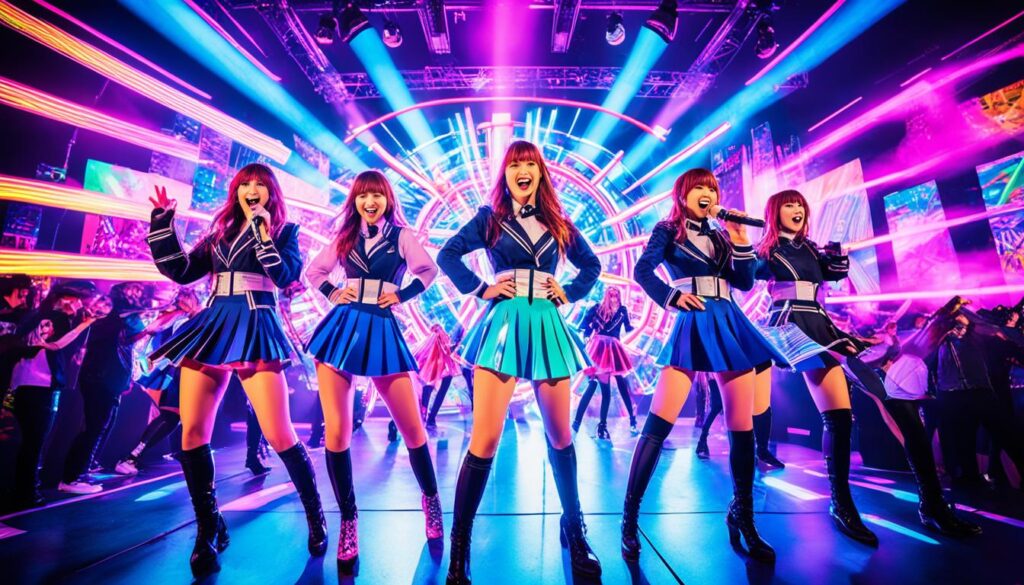
J-pop keeps growing and changing the music scene, both in Japan and worldwide. Its fun tunes and cultural impact have made it a key part of Japanese pop culture loved by many.
The World of Japanese Video Games
Japanese video games are well-known for their creative gameplay and stories. Games like Super Mario, The Legend of Zelda, Final Fantasy, and Persona are famous. They have become a big part of Japan’s popular culture. These games offer unique and deep experiences for players.
These games are successful because they care about the details and stories. They usually have deep stories that touch on Japanese culture, like Shintoism and Buddhism. This makes the game worlds rich and interesting for players.
Japanese games often teach good values about family, friends, effort, and never giving up. For example, Pokémon is about friendship and working together. It’s loved by people all over the world.
Japanese games also help spread Japanese culture around the world. They introduce players to Japan’s art, music, and stories. Many manga and anime shows, like “One Piece,” come from games. This mix of mediums shows the world Japan’s creative culture.
These games are praised for being creative, new, and easy to get into. They’ve made their own genres, like role-playing games (RPGs). These games are known for their great stories and characters. It’s a big part of what makes Japanese games stand out.
Playing games in Japanese can help you learn the language better. It’s a fun way to learn new words and practice speaking.
Over 75 million people play games in Japan, and the industry is worth about £16.2 billion. With so many games, including 500,000 on mobile, Japanese games keep being popular all over the world.
Japanese games have a major influence on pop culture. They have inspired manga, anime, movies, and TV shows. This has made Japanese art and stories loved by fans everywhere.
To sum up, Japanese video games stand out with their creativity and deep stories. These games are loved all over, influencing many other games. They’re a window into Japanese culture for people globally.
Fashion Trends in Japanese Pop Culture
Fashion is a key part of Japanese pop culture, known for its unique and bold styles. Harajuku, especially, is famous for its vibrant and eclectic fashion scene. It’s where people express themselves with avant-garde street styles.
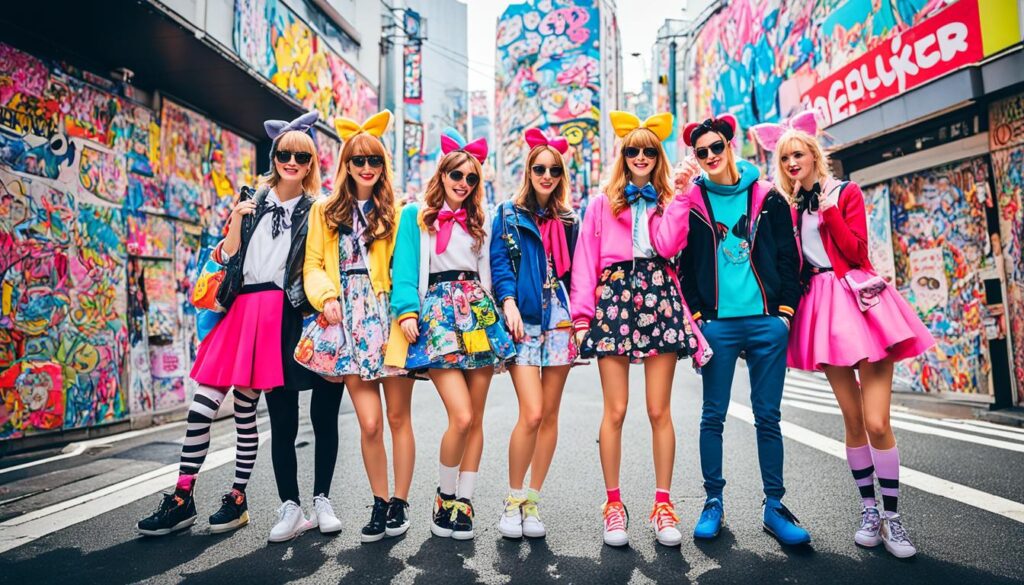
Harajuku fashion mixes colors, patterns, and styles boldly. It’s all about showing who you are through what you wear. People from all over come here to stand out with creative clothing and accessories.
Harajuku fashion is a playground for self-expression and experimentation. It blurs the lines between different styles, combining elements from various subcultures to create striking and unique looks.
Cosplay is a big part of Japanese pop fashion. It’s when fans dress up as characters from games, anime, and more. It’s now known worldwide, with big events celebrating this art form.
Japanese designers are also famous for their wild and creative designs. They break traditional fashion rules and push the limits. Their work is admired around the world.
Key Fashion Styles in Japanese Pop Culture
Japanese pop fashion has a wide variety of styles. Let’s look at a few that have really made their mark:
- Kawaii fashion: It means “cute” in Japanese. This style includes not just clothes but also behaviors. It’s a big part of Japanese culture’s cuteness trend.
- Lolita fashion: Lolita started in the 1980s. It takes cues from Victorian and Rococo, with frilly dresses and accessories. It’s loved in Japan and the West.
- Kimono fashion: Kimonos date back centuries. They’re known for rich patterns and are a key part of Japan’s tradition. Today, modern takes on kimonos are popular too.
- Visual Kei fashion: Visual Kei is similar to 1980s Glam rock. It features bold hairstyles, makeup, and outfits. This style is often connected to a certain type of music.
Japanese fashion plays a big role in setting global trends. It offers everything from Harajuku’s unique street style to high-fashion designs. This creativity from Japan captures people’s hearts all over the world.
The Technological Innovations in Japan
Japan is well-known for its cutting-edge technological progress and creative contributions. It leads in areas like robotics and virtual and augmented reality. These areas deeply influence the world’s markets and Japan’s own culture.
Japan ranks 13th in innovation among 132 economies, based on the 2022 Global Innovation Index. Its position has slipped since 2007 when it ranked fourth. It still maintains a strong global presence in technology, though.
Developing new technology can be hard for Japan. But they excel at using technology in everyday life. This integration makes technology a key part of Japanese society.
Japan has made several critical breakthroughs. They introduced the first wireless phone and developed dry-cell batteries. These inventions have had a worldwide impact. Japan is also known for advancements in various technologies, like magnetic resistance steel, and the first dedicated aircraft carrier.
Japanese technological impact is seen in electronics, audio gear, computing, and transportation. The country’s technical base is robust. It continues to progress in semiconductor technology, computer graphics, and high-speed trains.
Japan’s tech market was dominant in the late ’70s. However, it has met challenges in keeping up. Yet, Japan remains a top innovator and drives progress across many fields.
Japan’s TeamLab showcases the country’s tech creativity with digital art installations. These displays, found in the Digital Art Museum in Tokyo, have gained global attention. The company uses the latest tech to make unique art experiences for people.
NTT Laboratories is another leader in tech, focusing on extended reality. Their work enhances virtual experiences. For instance, the “Cho-Kabuki Powered by NTT” project mixes kabuki theater with advanced tech.
Sony CSL is leading in tech research with Jakuin in Kyoto. Their goal is to modernize the tea ceremony through innovative technology, such as time-of-flight sensors.
Cultural events are adapting to the pandemic. Festivals like Tanabata and Awa Odori have gone virtual, letting people celebrate from home.
Ikebana is also evolving with technology. AR lessons and computer-designed arrangements are offering new creative possibilities.
Japan values eco-friendly living. This shows in towns like Kamikatsu, where they aim for zero waste. People there strive for a sustainable life close to nature.
The ‘mottainai’ mindset is strong in Japan. It leads people to pick products with less waste. This has changed how Japanese consumers shop, promoting sustainability.
Along with these, Japan has developed 2.5 Dimensional Theatre as an art form. This innovation has grown in popularity in the last ten years.
The Tokyo 2020 Olympics focused on showcasing robotic technology. Prime Minister Shinzo Abe aimed to make robotics a key part of Japan’s economy. Companies like Toyota are working on self-driving cars for the event.
Companies like Uber and AirBnB have had a hard time in Japan due to legal, social, and cultural issues. Yet, Japan excels in digital innovation while keeping its unique cultural identity.
https://www.youtube.com/watch?v=CQfWP96bIV4
In wrapping up, Japan’s tech innovations have had a wide-reaching impact. They influence the world’s markets and Japan’s own culture. The nation remains dedicated to advancing in technology, contributing to both its economy and global impact.
Cultural Idioms and Translation Challenges
Translating Japanese pop culture can be tricky. It involves lots of idioms, slang, and cultural references. These things aren’t always easy to explain in other languages. Good translators know both Japanese and English well. They bridge the gap, ensuring nothing gets lost in translation. This way, the real feel of Japanese pop culture stays true.
English and Japanese have very different sentence structures and word orders. In English, we say the subject, then the verb, and finally the object. But in Japanese, it’s the subject, then the object, and lastly the verb. This can make translations tough. Skilled translators work hard to keep the meaning clear.
Japanese has many characters, like kanji, hiragana, and katakana. Each carries a specific meaning and culture. Translators must understand these deeply. This knowledge helps them get the message across just right in the target language.
Translating Japanese pop culture well needs high language skills. Translators should be really good in both Japanese and English. A deep understanding of both languages is key. It helps make the translation accurate and sensitive to culture.
“Translating idiomatic expressions and cultural references can be tough. Idioms have meanings beyond their words. They show a culture’s depth and importance. To translate them well, you need to know the language and the culture.”
Idioms are often hard to translate word for word. They are rooted in a culture’s history. This makes direct translation tricky. Without knowing the cultural context, the meaning can get lost.
Take the idiom “Break a leg” for example. It’s a wish for good luck in English. But translating it directly to Japanese doesn’t work. Translators must find an equivalent that carries the same good wishes across cultures.
Translating Idioms: A Ford Case Study
Ford once had a big translation mistake in Belgium. They were talking about their cars’ high-quality bodies. But it was translated to “high-quality corpse” by mistake. This blunder confused people and hurt Ford’s image. It shows how important it is to know idioms and cultural meanings well when translating.
“Idioms make a language richer. They speak to a community’s history and culture. While they’re great for deepening communication, they can be tough for translators. To get it right, you need to really know the culture.”
| Challenges in Translating Japanese Pop Culture | Translation Solutions |
|---|---|
| Translating cultural idioms and slang | Interpret idiomatic expressions, provide equivalent phrases, and ensure cultural sensitivity |
| Structural differences between Japanese and English | Adapt sentence structure and word order to maintain meaning |
| Kanji characters and their cultural connotations | Deep knowledge of kanji characters to accurately capture their essence |
| High level of language proficiency | Native or N1 to N2 level of proficiency in both Japanese and English |
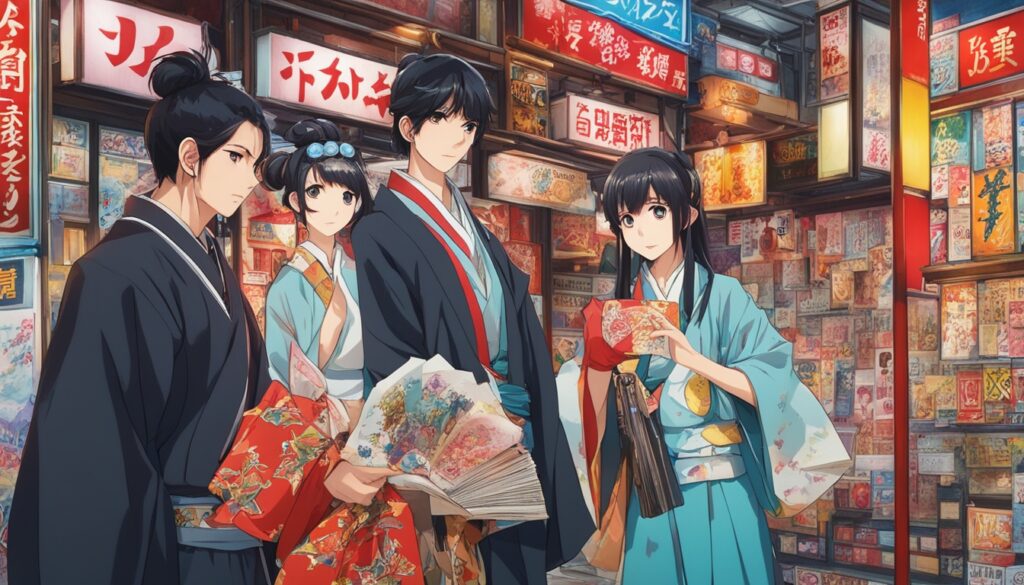
Tips for Enjoying Japanese Pop Culture in Translation
When you step into the world of Japanese pop culture through translations, remember a few key tips. They’ll make your experience better and help you enjoy the beauty and variety of Japanese pop culture more.
1. Embrace Cultural Differences
Japanese pop culture reflects its unique society. It includes different cultural aspects. Embrace these differences for a better experience. Translations might not capture every cultural detail. Understanding these differences ensures you enjoy Japanese pop culture in translation more.
2. Seek High-Quality Translations
Not all translations are the same. A good translation helps you understand and enjoy Japanese pop culture better. Look for translations by experts. They know how to keep the work’s true spirit alive.
3. Explore Online Forums and Translation Services
Find help for unknown terms or cultural points online. Forums and services can be great for this. They connect you with fans and experts ready to share insights. Translation services also offer help for a deeper cultural understanding.
4. Dive into Detailed Translations
Look for translations that offer more than just words. They should include detailed explanations and cultural notes. This extra information helps you grasp the full cultural meaning.
5. Stay Curious and Expand Your Knowledge
Japanese pop culture is rich and always growing. Fuel your interest by exploring various forms and creators. Books, blogs, podcasts, and documentaries are excellent resources. They provide deep insights into Japanese pop culture.
Follow these tips to make your Japanese pop culture experience richer. Keep an open mind, look for good translations, and stay curious. This way, you’ll discover the true depth and creativity of Japanese pop culture.
The Popularity of Japanese Pop Culture Worldwide
Japanese pop culture is loved all over the globe. It’s filled with unique ideas and deep emotions. From anime and manga to fashion trends and new gadgets, it has something for everyone.
What makes it so special is its ability to cross over language and culture. The amazing stories, beautiful animation, and characters connect with people globally. This helps share Japan’s history and values with the world.
After World War II, Japan started sharing its culture to create a positive image abroad. It used entertainment, such as anime, music, and movies, to do this. This effort not only won hearts but also helped Japan’s economy rebuild.
Post-war Japanese films also changed their focus, promoting peace instead of war. This change, combined with aiming movies and shows at kids, spread positive values. Thus, Japanese pop culture became a medium for good messages.
The Cool Japan project is another effort to showcase Japan’s culture globally. It highlights the country’s art and innovation over its past. In this way, Japan works to promote peace and unity through its culture.
Events like conventions and festivals are big in sharing Japanese pop culture. They bring people together and promote cultural exchange. Playing a major role, they elevate Japan’s presence around the world.
Japanese pop culture reaches millions through fashion, movies, and tech. The country is known globally for its manga, anime, and unique fashion sense. The anime industry, especially, has been key in spreading Japanese culture worldwide.
By exploring Japanese pop culture, we can learn a lot about Japan’s past and present. It shows us a world of endless creativity. The love for Japanese pop culture speaks to Japan’s huge impact on the global creative scene.
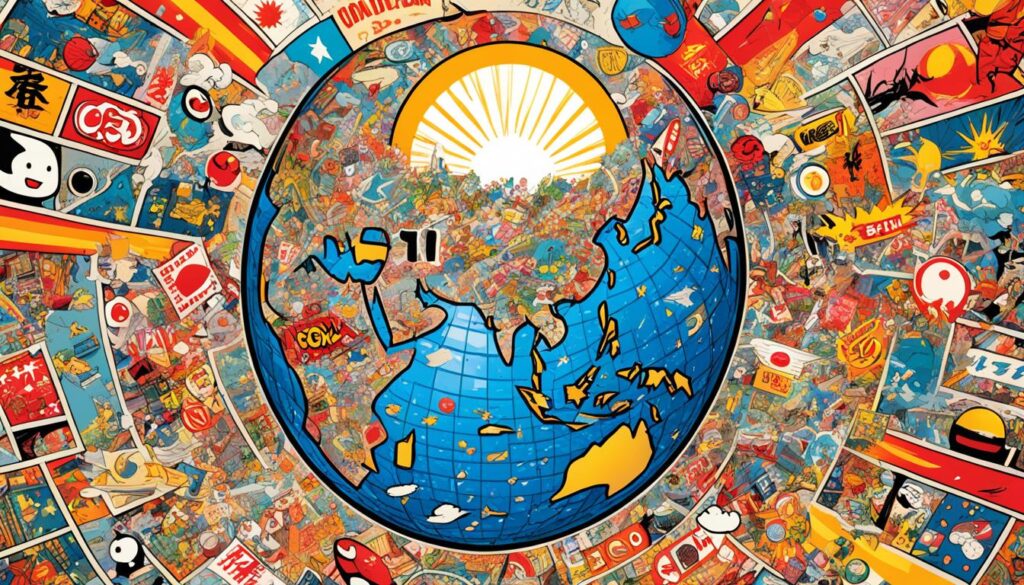
Japanese pop culture captures the imagination and resonates with diverse audiences worldwide, transcending language and cultural barriers. Its unique blend of creativity, innovation, and emotional depth showcases Japan’s cultural significance and captivates fans from all walks of life.
Learning Resources for Japanese Pop Culture
Are you eager to learn more about Japanese pop culture? There are many ways you can explore this vibrant world. You can find everything from websites, books, podcasts, and communities online. These resources are great for digging into different aspects of Japan’s popular culture.
Websites
Many websites are dedicated to Japanese pop culture. Japan Guide and Tofugu are two great examples. They cover anime, manga, fashion, and music in depth. With cultural insights and fun details, they help you dive deep into Japanese pop culture.
Books
Books offer a detailed look at Japanese pop culture. “A Geek in Japan” and “Japanamerica” are must-reads. They explore the history and cultural impact of anime, manga, fashion, and music. You’ll also learn about technological advances coming from Japan.
Podcasts
Podcasts are a fun way to learn about Japanese pop culture. The Tofugu Podcast and Anime World Order are popular shows. They talk about different parts of Japanese pop culture through discussions and interviews. Listening to podcasts helps keep you informed and inspired by the latest trends.
Online Communities
Joining online communities is a great way to meet others interested in Japanese pop culture. Websites like MyAnimeList and Japan Reference let you chat and learn with a community. They create a space for sharing knowledge and connecting with fans, enriching your learning experience.
Translating Japanese Pop Culture: A Gateway to Understanding Japan
Understanding Japan more deeply happens when we explore its pop culture. Non-Japanese speakers can learn a lot about the country by diving into its pop culture. This includes its history, traditions, and what its people value. Getting into anime, manga, and music lets fans all over the world dive into the uniqueness of Japan.
Unlocking the Language
The language barrier is a big hurdle to enjoying Japanese pop culture. Japanese uses three writing systems. Learning to read and write it does take time. Thankfully, there are many ways to learn, like textbooks, online courses, and schools.
The Job Market Advantage
Becoming fluent in Japanese is not just rewarding personally. It also gives a big boost in the job market. Many companies look for people who can speak Japanese well. With Japanese skills, you can explore jobs in tech, gaming, fashion, and business with other countries.
Programs for Cultural Immersion
Want a deep dive into Japanese culture? Check out the program happening from May 9 – June 3, 2022. You’ll get to learn the language better and see Japan’s pop culture up close. The travel dates are from May 9 – 25, 2022. You’ll get to know Japan, seeing famous places and meeting locals.
| Program Details | |
|---|---|
| Program Dates | May 9 – June 3, 2022 |
| Travel Dates | May 9 – May 25, 2022 |
| Cost to Participate | Program Fee ($4,311) + Tuition (Varies) + Technology Fee (Varies) + Out-of-pocket Expenses ($889) |
| Included in Program Fee | Roundtrip airfare from U.S. to Japan; accommodations while in the country; five group meals and some meals; local transportation. |
| Credits offered for RELIG 104 course | 3 |
| Credits offered for RELIG 491 course | 3 |
| Credits offered for GEOG 350 course | 3 |
| Credits offered for GEOG 452 Q course | 3 |
| Prerequisite for each course | None |
Exploring Japanese Pop Culture
Expect to dive into manga, anime, and more at the program. You’ll look at various aspects of Japanese pop culture, like video games and fashion. The program will talk about different parts of Japanese culture, showing you a broad view.
Diverse Perspectives and Interactive Discussions
A variety of people will share their knowledge at the lectures. This includes PhD students, experts, and someone who supervises. You’ll get a full look at Japanese pop culture. The lectures will also stress the importance of understanding different cultures.
At these lectures, you can talk with the speakers and others who love Japanese pop culture. This makes learning more fun and interesting. It’s a chance to share thoughts and learn from people with different viewpoints.
You can also join workshops on interesting topics, like AI’s role in studying culture and Japanese food culture. These sessions will add to your understanding of Japan’s culture and creativity.
By translating and exploring Japanese pop culture, you get closer to Japan’s culture. It lets you dive into the language, art, and entertainment. This ongoing interest builds connections and deepens your understanding of Japan.
The Impact of Japanese Pop Culture on Global Trends
Japanese pop culture is a major player in setting global trends. It shines in areas like fashion, entertainment, and technology. This creative spark has captured hearts worldwide, making a big mark on our culture.
Influencing Fashion Trends
Japan’s bold street fashion is known all over for its unique looks. It’s not a surprise that more people are buying fashion items with Japanese vibes. This shows how much Japanese pop culture affects the world’s fashion scene.
| Fashion Industry Data |
|---|
| The cool look of Japanese City Pop has left its mark on fashion and streetwear designs. Top brands like Gucci and Louis Vuitton have taken note, using City Pop styles in their clothes. This proves that 80s and 90s fashion is still a big hit. |
Transforming Entertainment
Anime and manga from Japan have caught the eye of viewers all over. Their stories and art styles are loved worldwide. They’re even inspiring entertainment beyond Japan, showing their deep impact on storytelling trends.
Shaping Music Trends
J-pop, the Japanese pop music scene, is making waves globally. The smooth tunes of City Pop from the 70s and 80s are especially popular. Many artists today look back to this nostalgic style for fresh inspiration.
Big names in music like Mac Miller and Tyler, The Creator are fans. They’ve used City Pop in their songs, proving its lasting appeal.
Incorporating Aesthetics into Film and Television
Japanese City Pop’s catchy tunes and vibes are making waves in movies and TV shows, too. You can hear it in films like “Lost in Translation” and shows like “Stranger Things.” Its unique sound adds to the emotion and cultural feel of these stories.
Inspiring Internet Culture
The internet is a key place where Japanese pop culture shines. Sites like YouTube and TikTok are full of City Pop remixes and memes. This has made the music more available to younger fans.
As a result, Japanese pop culture has become a big talking point online. It’s helping keep its influence fresh and widespread.
Overall, Japanese pop culture has left a mark in many parts of our lives. From what we wear to what we listen to and watch online, its unique style is everywhere.
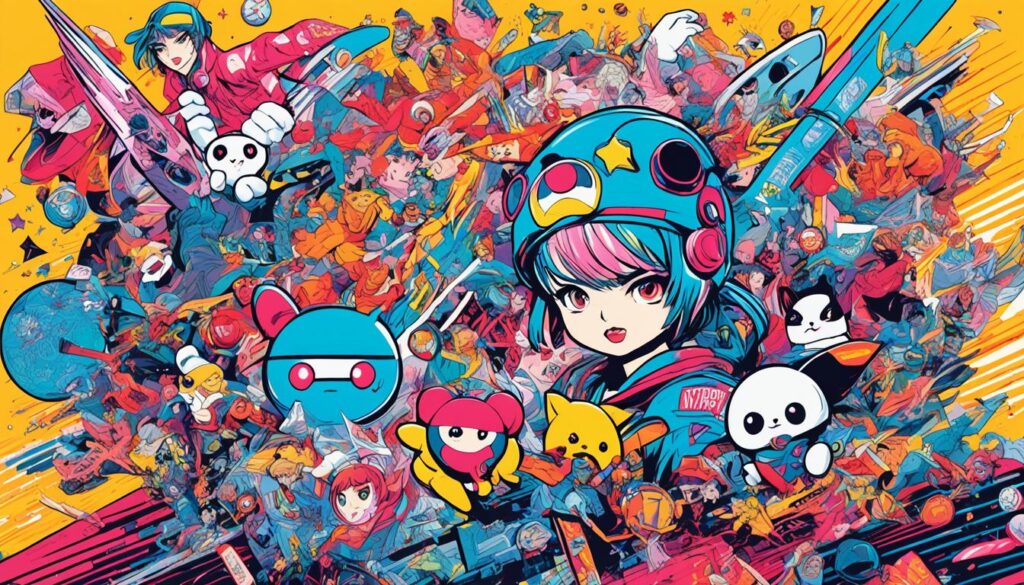
Embracing the Ever-Evolving Adventure of Japanese Pop Culture
Japanese pop culture is always changing and always exciting. It draws people in from all over the world. With its mix of anime, manga, fashion, and tech, there’s something for everyone. This makes it so popular.
The anime industry is at the core of this world. In 2019, it was worth 2.15 trillion yen, says the Association of Japanese Animations. But, Japanese pop culture isn’t just anime. It also includes things like real estate, construction, and movie making, all needing big money.
For many, the journey into Japanese pop culture starts on familiar TV channels, like SABC 2. School students in South Africa found out about Japanese anime here. The shows aired Monday to Thursday at 5 pm. This was their first step into this world.
An Ever-Growing List of Introductory Anime
“Death Note,” “Naruto,” “Fullmetal Alchemist,” “Code Geass,” and “Elfen Lied” are great anime for beginners. They help start a love for the stories and worlds of anime.
There was a time when liking anime wasn’t cool. In the mid-2000s, 65% of teens felt looked down upon for being fans. But now, anime is a big part of Western pop culture. Over 60% of top US musicians mention anime in their songs.
Many big stars support anime, with over 70% of them showing their love. Companies like Gucci are working with anime creators too, now more than ever. They’re mixing anime with high fashion, making it cooler than ever.
These days, it’s easy to watch anime, thanks to Netflix and other platforms. Every year, more people around the world start watching. Movies like Demon Slayer do really well globally. They prove that anime is loved all over.
Getting into Japanese pop culture is diving into a world of endless creativity. It’s an adventure that’s always bringing new things to discover. Fans play a big role in how the culture grows, always making it feel fresh and alive.
Conclusion
Japanese pop culture is an exciting force that’s loved worldwide. It’s seen a big increase in fans since the late 1900s. This culture includes anime, manga, video games, and unique fashion trends. Icons like Godzilla and Pokémon have won over hearts all over the globe.
In Japan, being cool on a worldwide scale is a big deal. This was identified as “Gross National Cool” by Douglas McGray. Joseph Nye argued that Japan’s entertainment exports help it shine on the world stage. Even the tragedies of Hiroshima and Nagasaki played a role in forming Japan’s creative spirit, according to Murakami Takashi.
After the war, Japan quickly rebuilt its consumer world. It now has a lot of people who love buying and exploring new things. This led to the creation of famous works like “Gojira” (Godzilla) and films by Hayao Miyazaki. Japanese pop culture includes everything from movies and food to TV shows and music.
Japanese pop culture is always changing and thrilling fans globally. It adds creatively to our world. Its contributions connect cultures and remain important in the world’s creative scene.
FAQ
What is Japanese pop culture?
Japanese pop culture includes anime, manga, fashion, and tech. These things are known all over the world. They bring in fun and new ideas.
What are anime and manga?
Anime is Japanese animation. Manga are Japanese comic books. They tell stories about many things, like science fiction or love.
What is J-pop music?
J-pop is catchy, upbeat music from Japan. It’s loved in Japan and in many other countries. It features great singers and musicians.
What makes Japanese video games unique?
Japanese video games stand out for their cool gameplay and stories. They are well-liked across the globe for their creativity and characters.
What is Harajuku fashion?
Harajuku fashion is about being bold and different. It comes from a famous area in Tokyo. Many love its colorful style.
How has Japanese technology influenced pop culture?
Japan’s tech, like robots and virtual reality, is a big part of Japanese pop culture. It plays a key role in making video games, anime, cars, and gadgets.
What challenges are faced when translating Japanese pop culture?
Translating Japanese pop culture can be hard because of different expressions and slang. It needs experts to keep its full meaning and flavor.
How can I enjoy Japanese pop culture in translation?
To enjoy its translation, embrace the differences in culture. Look for good translation service online to understand hidden meanings.
Why has Japanese pop culture gained popularity worldwide?
It’s loved worldwide for its unique creativity and deep emotions. It speaks to people everywhere, crossing over language and culture.
What resources are available for learning about Japanese pop culture?
Websites, books, and podcasts are full of info on Japanese pop culture. They shed light on its anime, manga, fashion, and more.
How does translating Japanese pop culture help in understanding Japan?
It opens a door to Japan’s history, traditions, and values for non-Japanese speakers. It increases love for Japan’s art and entertainment.
How has Japanese pop culture influenced global trends?
It greatly affects fashion, entertainment, and tech worldwide. Its unique stories, creativity, and looks shape what many people like.
What makes Japanese pop culture an ever-evolving adventure?
It’s always changing and bringing new things for people to love. From anime and manga to fashion and gadgets, there’s always something exciting.
